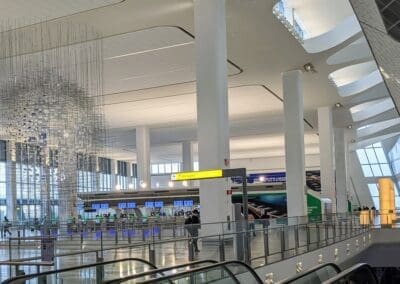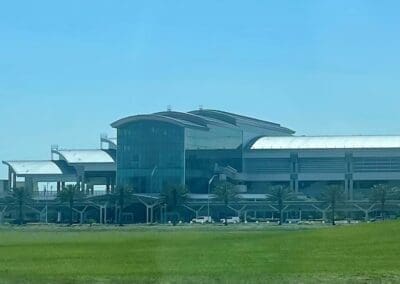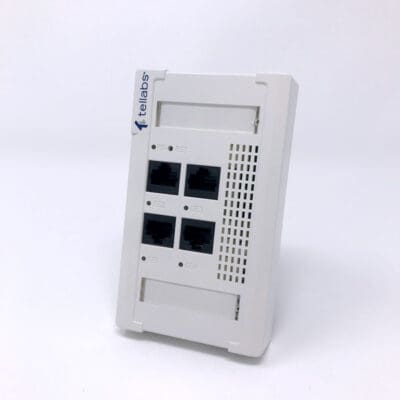Sustainability
The adoption of Optical LAN can make immediate tangible contributions to sustainability goals, reducing embodied and operational carbon impacts, plus aiding net-zero initiatives.
Optical LAN delivers quantifiable benefits to healthy, green, and smart building design
Organizations are realizing benefits by making their buildings healthy, energy-efficient, and sustainable. These improvements include operational cost savings, a positive impact on employees, and an improved public image. As a result, many are actively accelerating programs to expand these goals. To uphold these standards of healthy, sustainable, and technologically advanced buildings, it is essential for the IT management team to get involved. The IT personnel are responsible for assessing the practicality of their network systems to determine if alternatives better align with social and environmental values.
Passive Optical LAN is an intelligent network option for enterprises seeking to establish high-performing buildings and campuses. Optical LANs have proven to be more energy-efficient, environmentally friendly, and require less space on floors, racks, risers, pathways and telecom rooms. Thus, organizations looking to gain certifications related to high-performance, health, and sustainability in their buildings should consider an Optical LAN design. This technology provides concrete benefits that align with goals related to green initiatives, climate/health, energy consumption, circular economy, embodied carbon reduction, and net-zero corporate objectives.
Click here to learn about our Optical LAN carbon reduction calculator for enterprise networks
Quick Facts
- Smaller footprint and less natural resources
- 60% savings in energy utilization
- 59% reduction in A/C system power
- 5 times less carbon dioxide (CO2)
- 13 times reduction in ozone depleted
- Improved resiliency and product lifecycle
Optical LAN positive impact for sustainability is big and includes a rippling effect multiplier
Reduced Space Requirements and Smaller Footprint
In the main data center room, Optical LAN offers 4x better Ethernet density from a smaller footprint. By occupying less rack area, you save physical space, and with OLAN’s great aggregation capabilities, you save ports plus money at the core router too. For the telecommunication rooms, OLAN design gives you the opportunity to reduce or eliminate the telecommunication rooms. When you exit the telecom rooms you gain a rippling effect of reducing air conditioning, fire suppression systems, security surveillance, and other building materials needed. Within the cabling pathways, the single mode fiber (SMF) can carry as many as 128 gigabit Ethernet connections across a single cable with OLAN. OLAN deep fiber design, every 4-port Optical Network Terminal (ONT) provides a 4 to 1 reduction in cabling between the telecom closet and the connected devices. Because of the reduced number of J-Hooks for cabling they can be used in the horizontal pathways instead of more substantial cable trays.
Less Equipment, and Less Natural Material
Optical LAN prioritizes the use of fiber cabling while minimizing the use of copper cabling, resulting in the introduction of far less copper into buildings. This is particularly beneficial as copper mining activities have a track record of being environmentally destructive. Additionally, silicon (i.e., glass) is the 2nd most abundant material in the earth’s crust. Reducing the number of plastics and PVCs that burden a building is another significant green benefit of Optical LAN. SMF cabling has 60% less plastic jacketing due to its smaller circumference. As previously mentioned, every 4-port ONT provides a 4 to 1 reduction in cabling, which can help reduce the smoke load of a building, a critical safety aspect. This reduction in infrastructure has a far-reaching effect that can significantly lower the weight impact on a building’s shell, which architects and engineers appreciate when calculating embodied carbon reduction.
Minimizing Embodied and Operational Carbon Impact
Operational carbon is energy consumption from network electronics, lighting, power, HVAC and other infrastructure operations. Embodied carbon represents emissions during building construction, including raw material extraction, processing, manufacturing, distribution, installation and end-of-life/disposal for all building materials. With Optical LAN, a 34-story building with 11,500 connections can reduce cable length by 50%, cable weight by 71%, waste by 70% and embodied carbon by 75%. Relative to operational carbon, this same building can enjoy lower energy use of up to 60% and lower HVAC saves another 60% in electricity based on an Optical LAN design.
Lower Energy Consumption and Heat Dissipation
Optical LAN can lower the power demands of the network in one building (e.g. 2,000 Ethernet connections) by as much as 30-50%, which further contributes to operational carbon reduction calculations. At Tellabs, some of our larger customers, like the Department of Energy Sandia National Laboratory, have saved up to 65% in power consumption due to OLAN (e.g. 1 million kWh saved per year at Sandia). Energy can be saved by reducing air conditioning because of the reduced or eliminated need for telecom rooms, and because the ONTs and OLTs can operate within extended temperature ranges. We have observed that delivery of Power over Ethernet (PoE) can be more efficient over an OLAN architecture, resulting in as much as a 13% power saving with PoE over OLAN!
Extended Technology and Product Lifecycle Longevity
This is the holy grail for circular economy and technology resiliency! First, investing in a fiber-based enterprise LAN infrastructure leads to fewer cable refreshments. Fiber often has a warranty that lasts 25-30 years, while copper cabling is historically ripped out of buildings every 7-10 years – which has a huge negative impact on landfills. Second, there is less equipment refreshed with Optical LAN. We have already witnessed Gigabit Passive Optical LAN (GPON) being upgraded to 10 gigabit XGS-PON while keeping the same fiber cabling and passive optical splitters. The same will hold true for 40G or 100G NG-PON too! OLAN design does an excellent job of decoupling technology upgrades, such as IEEE 802.11ax Wi-Fi 6. If you already have an OLAN installed in your building or campus, upgrading to Wi-Fi 6 only requires adding 10G XGS-PON XFPs pluggable optics at the OLT and 10G XGS-PON ONTs, and then equipping those ONTs with multi-rate Ethernet SFP+ pluggable optics (e.g. 1G, 2.5G, 5G, and 10G Ethernet) to connect the Wi-Fi 6 wireless access point. OLAN’s support of multi-wavelength is a game-changer! It allows you to stack multiple 10 gigabit XGS-PON wavelengths over the same fiber infrastructure you originally invested in, which means you can grow this network to a 40-gigabit capacity or greater. Why is extended technology and product lifecycle longevity so important? It’s important because technology and product resiliency keep electronics, plastics and all other harmful materials from negatively impacting landfills.
Looking for more information?
If you still need additional details, and even greater technical explanation, then click on the “Download Overview” button below to access our comprehensive Optical LAN sustainability solution overview.




